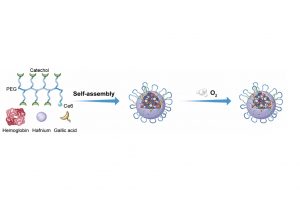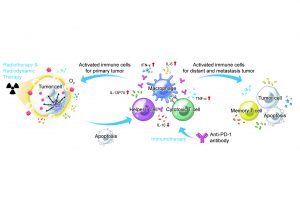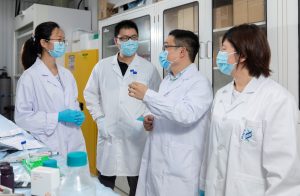Assistant Professor Dai Yunlu’s research team in the University of Macau’s (UM) Faculty of Health Sciences (FHS) has designed and synthesised an oxygen-enriched metal-phenolic X-ray nanoprocessor to enhance the therapeutic effects of anti-tumour radiotherapy. The nanoprocessor can improve radiodynamic therapy and enhance anti-tumour immune response by focusing the ionised energy generated by radiotherapy in the tumour microenvironment while generating ROS to induce cancer cell damage. The study has been published in the top international academic journal Advanced Science.
Radiotherapy is a traditional cancer treatment that has been proven to be effective in all types of cancer treatment. However, the toxicity of high doses of radiation to normal tissues and the inhibition of toxic substances during radiotherapy limit the effectiveness of radiotherapy. To overcome this limitation, the research team developed an oxygen-enriched X-ray nanoprocessor: Hb@Hf-Ce6 nanoparticles, which can be used in combination with PD-1 antibody to improve the therapeutic effects of radiotherapy and radiodynamic therapy and enhance anti-tumour immune response.
Hb@Hf-Ce6 nanoparticles are prepared based on the structure of metal polyphenol coordination, which integrates all functional molecules into nanoparticles to achieve multifunctional anti-tumour effects. The polyphenol structure modified by chlorin e6 (Ce6) is coordinated with high-Z radiotherapy sensitisers (hafnium, Hf), and the oxygen carrier hemoglobin (Hb) is chimeric in the coordination structure to overcome radiation tolerance associated with hypoxia. Specifically, under X-ray radiation, the radiation-induced physical process stimulated by Hf can activate the photosensitiser Ce6, thereby generating high levels of ROS to induce cancer cell damage.
The results of an in vitro breast cancer 4T1 cell experiment showed that Hb@Hf-Ce6 nanoparticles enhanced tumour cell death induced by radiotherapy and radiodynamic therapy. In addition, the introduction of immune checkpoint inhibitor enhanced immune response induced by radiotherapy and radiodynamic therapy in 4T1 orthotopic and bilateral tumour model, thus achieving efficient and long-term inhibition of tumour growth and metastasis. In conclusion, this combined therapeutic strategy induces a comprehensive anti-tumour immune response targeting cancer eradication and metastasis inhibition. This study proposes a multifunctional metal polyphenol nanoplatform, which can be combined with immunotherapy to achieve efficient X-ray-mediated radiotherapy-radiodynamic therapy, to provide new therapeutic options for cancer treatment.
Prof Dai is the corresponding author of the study. PhD student Sang Wei and post-doctoral fellow Xie Lisi are the co-first authors. Deng Chuxia, dean of the FHS; post-doctoral fellows Li Bei and Li Jie; as well as PhD students Wang Guohao, Zhang Zhan, and Guo Sen also made important contributions to the study. This research project was funded by the Science and Technology Development Fund, Macao SAR (file number: 0109/2018/A3 and 0011/2019/AKP) and UM (file number: SRG2018-00130-FHS). The full-text version of the research article can be viewed at: https://onlinelibrary.wiley.com/doi/10.1002/advs.202003338
Source: Faculty of Health Sciences
Media Contact Information:
Communications Office, University of Macau
Albee Lei Tel:(853) 88228004
Judite Lam Tel:(853) 88228022
Email:prs.media@um.edu.mo
UM Website:www.um.edu.mo



